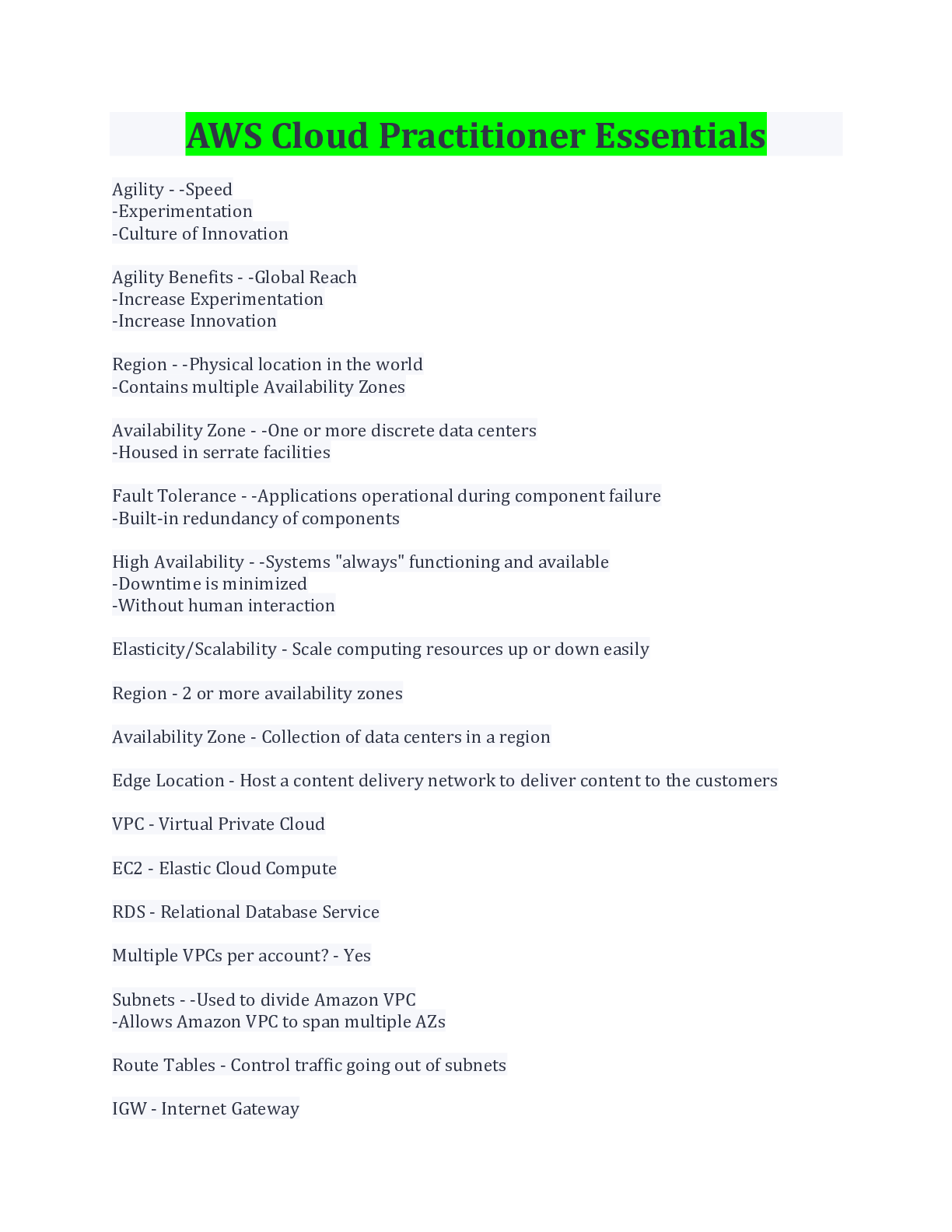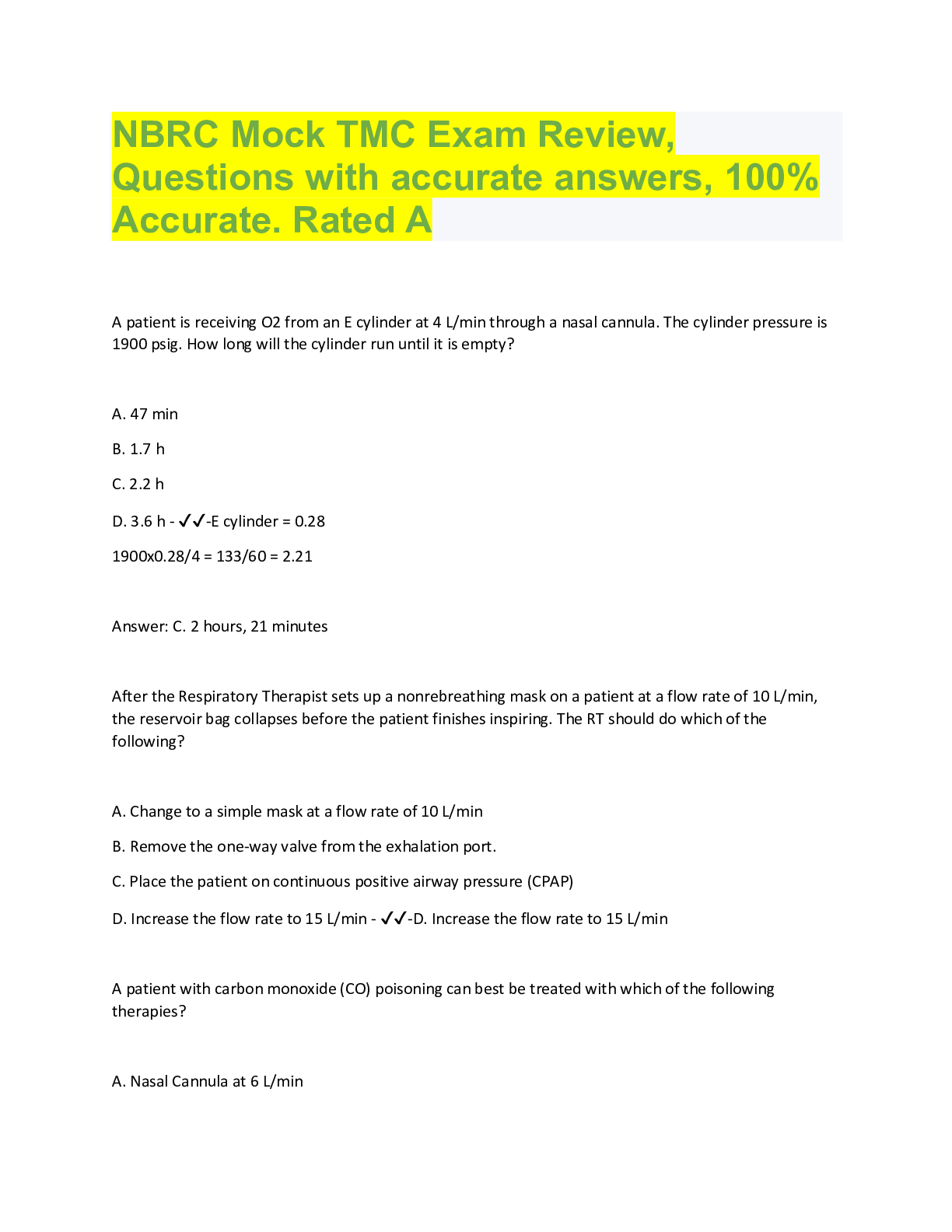*NURSING > EXAM > N_ NR442 - RN Community Health Practice Assessment B (50 Items)_Complete Solution Rated A (All)
N_ NR442 - RN Community Health Practice Assessment B (50 Items)_Complete Solution Rated A
Document Content and Description Below
NR442 - RN Community Health Practice Assessment B (50 Items) 1. A nurse is assessing a new client. Which of the following information should the nurse include in the cultural portion of the assessm... ent? a. Food preferences b. Employment status c. History of illnesses d. Sexual orientation Rationale: Food preferences are a part of cultural assessment. 2. A nurse is preparing an educational program about influenza for a group of community health nurses. Which of the following activities should the nurse include as an example for tertiary prevention? a. Offer classes to elementary school teachers about handwashing. b. Provide information to occupational nurses about the reasons for employees to not come to work. c. Administer antiviral meds within 48 hr to clients who have manifestations of influenza. d. Provide immunizations at long-term care facilities. Rationale: Tertiary prevention involves ways to reduce the complications of illness, which includes administering antiviral medications to clients who already have influenza. 3. Anurse is collecting demographic data as a part of a community assessment. Which of the following info should the nurse include? a. Racial distribution b. Family genograms c. Number of open water sources d. Presence of condemned buildings Rationale: Racial distribution is part of demographic data. 4. A community health nurse suspects an outbreak of scabies in the local area. which of the following actions should the nurse take first? a. Determine the incidence rate b. Institute prophylactic treatment c. Educate the community about disease transmission d. Discuss treatment plans with clients' families Rationale: The first action the nurse should take when using the nursing process is to determine the number of new cases of scabies in the community. 5. A public health nurse is planning care for four clients. Which of the following interventions should the nurse recognize as tertiary prevention? a. Providing chemoprophylaxis for malaria to a client who is traveling to mosquito- infested countries b. Administering antibiotics to a client who has AIDS and was diagnosed with pneumocystis jiroveci c. Performing a serological screening for HIV for a client who is pregnant d. Participating in partner notification for a client who has an STI ‘= Rationale: Administering antibiotics to a client who has AIDS and was diagnosed with Pneumocystis jiroveci is an example of tertiary prevention. 6. A home health nurse is assessing an older adult client who is taking captopril to treat heart failure. Which of the following findings should the nurse identify as an adverse effect of this medication? a. dry cough b. weight gain c. ataxia d. photophobia Rationale: Captopril prevents the conversion of angiotensin I to angiotensin II, causing bradykinin to accumulate. The client may experience coughing as a result of bradykinin accumulation. 7. A home health nurse is caring for a client who has breast cancer. Which of the following assessment findings should the nurse identify as an indication that the client is coping effectively? a. Inability to concentrate b. Makes eye contact c. Excessive sleeping d. Lack of interest in food Rationale: The nurse should recognize that making eye contact is a characteristic of effective coping. 8. A public health nurse is providing information to a client who has an alcohol use disorder and is asking about treatment. Which of the following statements should the nurse identify as an indication that the client understands the information? a. "I will not have to completely stop drinking alcohol if I go into an inpatient treatment program." b. "Once I make it through detoxification, I will be free of my addiction." c. "I am not eligible for an outpatient program until I have completed an inpatient program first." d. "I can expect to get help with other aspects of my life while in treatment." Rationale: Successful treatment of alcohol use disorder is more likely if the client receives help in other areas of his life, such as his physical health, psychological well-being, and family interactions. 9. The daughter of a client who is terminally ill and at the end of life approaches a hospice nurse and asks what she can do to help relieve her father’s pain. Which of the following interventions should the nurse suggest? a. Give the client brief hand massages. b. Increase the illumination in the room. c. Place a warm cloth on the client's forehead. d. Administer citalopram when the client is agitated. Rationale: Soft massage and brief hand massages can reduce pain and stress in palliative care settings. 10. A community health nurse is developing a plan of care for a client who is hispanic. which of the following actions should the nurse include in the plan? a. maintain direct eye contact when speaking with the client b. avoid using hand gestures when working with the client c. discourage the client from using a faith healer d. Use therapeutic touch during conversation Rationale: A client who is Hispanic might view touch as a gesture of caring and compassion. 11. A nurse is caring for a client who has AIDS and is experiencing rapid weight loss. which of the following actions should the nurse take first? a. Examine the client's oral mucous membranes. b. Encourage the client to consume 1.2 to 2.0 g/kg of protein daily. c. Recommend the client increase her daily calorie intake by 25%. d. Teach the client about findings that should be reported to the provider. Rationale: The first action the nurse should take when using the nursing process is to assess the client. The nurse should examine the client's oral mucous membranes for painful lesions, such as candidiasis. 12. A school nurse is discussing levels of prevention with a teacher. which of the following activities should the nurse identify as a primary prevention strategy? a. Provide nutritional counseling for students who have diabetes. b. Report suspected child neglect to the proper authorities. c. Conduct vision and hearing screening for kindergarten enrollment. d. Demonstrate proper handwashing techniques. Rationale: This is an example of primary prevention, the goal of which is to promote health and prevent diseases from developing. 13. A school nurse is conducting hearing screening procedures in an elementary school. Which of the following instructions should the nurse provide when performing the Rinne test? a. "After I place the tuning fork on your scalp, tell me if you hear the sound better in one ear or the same in both ears." b. "Use your finger to close one ear while I whisper some numbers into your other ear." c. “After I place this tuning fork behind your ear, tell me when you no longer hear the sound." d. "You'll wear headphones and press the button when you hear a sound." Rationale: This is the appropriate instruction for a Rinne test, a hearing evaluation that compares air conduction and bone conduction of sound. 14. A public health nurse is developing a presentation for local daycare providers about infectious childhood diseases. which of the following statements should the nurse include? a. "Respiratory syncytial virus is spread through contact with respiratory secretions from an infected person." b. "Rotavirus infections in children peak during the summer months." c. "Children who have fifth disease will exhibit bloody diarrhea." d. "Antiviral medications shorten the duration of shigella infection." Rationale: The nurse should include this statement in the presentation, as respiratory syncytial virus (RSV) is spread by direct contact with respiratory secretions while within 3 feet of a person who is infected. Manifestations of RSV include dyspnea, tachypnea, coughing, and wheezing. 15. A public health nurse is developing a visual health program by using a community-oriented approach. Which of the following interventions should the nurse include? a. Teach a client who has a vision loss about safety in the home environment. b. Provide genetic counseling to the family of a newborn who has congenital cataracts. c. Consult with the local school nurse to schedule yearly vision screenings for students. d. Develop a plan of care for a client who was newly diagnosed with glaucoma. Rationale: Consulting with the local school nurse to schedule yearly vision screenings for students focuses on the health care of a population rather than illness care for individuals. Therefore, this intervention is using a community-oriented approach. 16. A nurse in a rural health clinic is caring for a client who has heart failure. The client states "I'm not going to take any more heart medicine." Which of the following responses should the nurse make? a. "Why did you decide to stop your heart medicine?" b. "Can you tell me more about your decision to stop your medicine?" c. "Don't you know what stopping your medicine will do to your heart?" d "Don't you think your doctor knows what's best for your heart?" Rationale: The nurse is asking an open-ended question, which encourages continued communication and allows the nurse to investigate the reasons why the client has decided to stop taking the medicine. 17. A case manager is delivering a discharge plan for a client who has a spinal cord injury and is in a rehabilitation facility. Which of the following actions should the nurse take first a. Hold a care conference with the client and his family to discuss treatment options. b. Contact service providers to determine the availability of services offered. c. Determine the client's ability to perform self-care. d. Evaluate the client's satisfaction with the case manager's services. Rationale: The first action the nurse should take when using the nursing process is to assess the client's needs. Determining a client's needs is the first step of the case management process. Therefore, the nurse should first determine the client's ability to perform self-care. 18. A home health nurse is scheduling client visits for the day. which of the following clients should the nurse plan to visit first? a. A client who is 10 days postoperative following a mastectomy and needs to have surgical staples removed b. A client who has diabetes mellitus and reports new erythema to the left foot c. A client who has COPD and needs a follow-up visit related to home oxygen therapy d. A client in a hip spica cast who reports pruritus under the cast Rationale: When using the urgent vs nonurgent approach to client care, the nurse should determine that the client who has diabetes mellitus and a new onset of erythema to the left foot should be seen first. This client is at risk for infection and requires prompt evaluation and treatment. 19. A home health nurse is scheduling client visits for the day. Which of the following clients should the nurse plan to visit first? a. Conducting screenings for dental caries in the local school system b. Reviewing county health records for data on cases of chickenpox c. Providing a client with information about preventing d. STIs Documenting medication compliance for clients who have tuberculosis Rationale: Reviewing health records is an example of using epidemiological principles to analyze incidence and track outcomes of interventions for a particular disease or condition. 20. A community health nurse is teaching a client who was newly diagnosed with active pulmonary tuberculosis about disease transmission. Which of the following information should the nurse include? a. Household members should be placed in respiratory isolation b. The client should have a repeat purified protein derivative test in 3 months c. The client should use disposable utensils during meals d. Household members should take isoniazid for 6-12 months Rationale: Household members of a client who has active pulmonary tuberculosis are at risk for developing the disease. Therefore, taking isoniazid prophylactically for 6 to 12 months is recommended. 21. Monitoring medication compliance for a group of migrant workers who are being treated for TB. the nurse should use info from which of the following resources to assist with this process? a. Migrant Clinicians Network (MCN) b. U.S. preventive services task force (USPSTF) c. Agency for healthcare quality and research (AHRQ) d. Centers for disease control and prevent a. migrant clinicians Network (MCN) Rationale: Migrant workers frequently change locations and move from job to job. This can interfere with the client adhering to the 6 to 12 month TB treatment plan. The MCN is a tracking program developed so that health care providers can access prior provider information and maintain TB treatment continuity for the migrant population. 22. A school nurse is teaching health promotion to a group of staff members who sit at a desk and use a computer for 8 hrs at a time. Which of the following information is a priority for the nurse to include? a. "Take a walk after work." b. "Point and flex your toes periodically." c. "Have your visual acuity assessed regularly." d. "Adjust your chair so that your elbows are at desk height." Rationale: The greatest risk to staff members who are immobile for long periods of time is a venous thromboembolism. Therefore, the nurse should encourage the staff members to frequently change the position of their feet and legs. 23. 23. a. "Once I determine that a client is not at risk for abuse, I do not need to ask about it at future visits." b. "I should not document the name of the person the client accuses of the abuse in the client's medical record." c. "I should wait until I see signs of physical abuse before I help the client develop a safety plan." d. "I should refer a client for a rape kit examination if she reports sexual assault within the previous 24 hours." Rationale: Clients should undergo a rape kit examination if they report sexual assault within the last 24 hr. Evidence-based practice indicates that a health care provider should collect a rape kit if a client reports sexual assault within the previous 48 hr to ensure accurate collection of evidence. Current research is ongoing regarding this time frame. The nurse should also provide information regarding support groups and resources for clients who were sexually assaulted. 24. 24. a. Show the client a video about how to monitor blood glucose levels b. Give the client a pamphlet about foot care C. Observe the client's technique for drawing up insulin d. Review the color diagram of the food pyramid with the client Rationale: 25. 25. a. Clients should undergo a rape kit examination if they report sexual assault within the last 24 hr. Evidence-based practice indicates that a health care provider should collect a rape kit if a client reports sexual assault within the previous 48 hr to ensure accurate collection of evidence. Current research is ongoing regarding this time frame. The nurse should also provide information regarding support groups and resources for clients who were sexually assaulted. Clients who have prior exposure to violence have a greater potential for continuing the violent and abusive behavior. b. client lives in the same neighborhood where he spent his childhood years b. a client states he witnessed his mother physically mistreat his father c. a client states that her mother-in-law provides childcare while she is working d. a client participates in volunteer activities in the community b. a client states he witnessed his mother physically mistreat his father c. d. Rationale: 26. A nurse on the scene following a mass casualty explosion is triaging a client who has a large, open occipital wound and the following findings: respiratory rate 6/min, atonal pattern; capillary refill time 4.5 seconds; non responsive to painful stimuli. Which of the following actions should the nurse take? a. Apply a cervical spine collar and perform a focused neurological exam b. Turn the client to left semi-fowler's position and begin assessing the next client c. Place a firm pressure dressing on the occiput and open the airway d. Request that the client be assessed immediately by the next available provider Rationale: Principles of triage indicate that clients who have extensive injuries and a low- probability of survival do not receive treatment. Therefore, the nurse should provide only comfort measures before moving on to assess the next client. 27. A nurse in a community center is preparing to administer a tuberculin skin test to multiple clients to screen for TB. Which of the following actions should the nurse take? a. insert the needle at a 45 degree angle b. create a wheal that measures about 15 mm in diameter c. preparing the outer aspect of the upper arm for the injection d. inject 0.1 mL of purified protein derivative Rationale: The nurse should inject 0.1 mL of purified protein derivative, which is equivalent to 5 tuberculin units. 28. A nurse at a county health clinic is caring for a client who has recently assumed the role of primary caregiver for her mother. Which of the following statements by the client indicates that she is experiencing role conflict? a. I feel overwhelmed with not having enough time for my mom as well as my children b. I hope my siblings will be able to visit and help care for my mom for a few days c. I don't think my partner likes having to help more with the household chores d. I am glad that my job is flexible, so i can accommodate to my moms needs Rationale: Role conflict occurs when a client performs two or more roles that are in opposition to each other. Caring for children and a parent can cause feelings of stress for the client and lead to conflict within the family. 29. 29. a. "I will need to purchase exercise equipment before I can start." b. "I should try to perform aerobic exercise for an hour a day, 5 days a week." c. "I will see my doctor before beginning an exercise program." d. "I should avoid participating in weight-lifting exercises." Rationale: The client should see his provider before beginning an exercise program. The client should receive a complete physical exam and obtain approval for exercise. 30. A community health nurse is teaching a client who is overweight about steps to take to begin an exercise program. the nurse should identify that which of the following statements is an indication that the client understands the teaching? a. Respiratory disorders b. Diabetes mellitus c. Sickle cell anemia d. Hypertension Rationale: Farmers are at an increased risk for respiratory disorders due to exposure to agricultural chemicals, such as herbicides and pesticides. Other health risks for farmers include accidents with vehicles and machinery, dermatitis, dental problems, and stress and anxiety disorders. Instruct the interpreter to guide the nurse in providing information in a culturally- sensitive manner is correct. The nurse should rely on the interpreter to inform him how he should deliver information that workers might find culturally sensitive because the interpreter will have more knowledge about these issues. Ask the interpreter to add information she feels may be necessary is incorrect. The nurse should ask the interpreter to not add or omit any information because it can interfere with the accuracy of the content. Choose an interpreter who speaks the workers' language and dialect is correct. The nurse should choose an interpreter who can speak the clients' native language, including the specific dialect, in order to facilitate accurate communication. Evaluate the interpreter's approach to clients prior to the educational session is correct. The nurse should evaluate the style of the interpreter prior to the educational session to determine if she is able to develop a trusting relationship with the migrant workers in order to promote effective communication. Encourage the interpreter to paraphrase the workers' questions and responses is incorrect. The nurse should ask the interpreter to translate the workers' comments and questions using their own words to increase the accuracy of the communication. 31. Instruct the interpreter to guide the nurse in providing information in a culturally-sensitive manner. Ask the interpreter to add information she feels may be necessary. Choose an interpreter who speaks the workers' language and dialect. Evaluate the interpreter's approach to clients prior to the educational session. Encourage the interpreter to paraphrase the workers' questions and responses. a. "It sounds like you are probably an alcoholic." b. "Don't you think your family is being affected by your drinking?" c. "Can I give you some information about Alcoholics Anonymous?" d. “I don't think your mom would have approved of your drinking." Rationale: The nurse is giving information to the client, which conveys a sense of caring. This also allows the nurse to provide additional information on resources that can help the client. (Select All That Apply) 32. An occupational health nurse is planning to use an interpreter during an educational session with a group of migrant workers who do not speak the same language as the nurse. Which of the following actions should then use take? (Select All That Apply) a. "It sounds like you are probably an alcoholic." c. Ask the interpreter to add info she feels may be necessary d. Encourage the interpreter to paraphrase the workers' questions and responses d. choose an interpreter who speaks the workers language and dialect a. Evaluate the interpreter's approach to clients prior to the educational session b. instruct the interpreter to guide the nurse in providing info in a culturally sensitive manner Rationale: The nurse is giving information to the client, which conveys a sense of caring. This also allows the nurse to provide additional information on resources that can help the client. 33. The nurse is giving information to the client, which conveys a sense of caring. A client who is traveling to northern Europe. An infant who has bronchiolitis An infant who is 4 weeks old ad a client who is moving into a college dormitory allows the nurse to provide additional information on resources that can help the client. a. An older adult client who was treated in the emergency department last night for a stage III pressure ulcer A school-age child who was treated in the emergency department last night with status asthmaticus An older adult client who has a newly prescribed antihypertensive medication and needs a BP check A school-age child whose percutaneous endoscopic gastrostomy (PEG) tube needs changing. An older adult client who was treated in the emergency department last night for a stage III pressure ulcer A school-age child who was treated in the emergency department last night with status asthmaticus An older adult client who has a newly prescribed antihypertensive medication and needs a BP check A school-age child whose percutaneous endoscopic gastrostomy (PEG) tube needs changing b. An older adult client who was treated in the emergency department last night for a stage III pressure ulcer c. A school-age child who was treated in the emergency department last night with status asthmaticus d. An older adult client who has a newly prescribed antihypertensive medication and needs a BP check A school-age child whose percutaneous endoscopic gastrostomy (PEG) tube needs changing Rationale: When using the airway, breathing, circulation approach to client care, the nurse should determine that the client who recently experienced status asthmaticus is the priority. Therefore, the nurse should visit this client first. 34. The individuals living in crowded areas, such as dormitories, should receive the meningococcal vaccine. a. b. c. d. Rationale: 35. A nurse is conducting a home visit with a female client who reports a history of intimate partner abuse. The nurse should identify that which of the following findings places the client at greatest risk for domestic violence? a. The client is at 13 weeks of gestation. e. b. The client states she is leaving her partner. c. The client recently started a new job. d. The client visits friends without her partner's knowledge. Rationale: A client's decision to leave her partner places her at greatest risk for intimate partner abuse because the perpetrator can view her as a possession and fear loss of control. Whether the client actually leaves the relationship or just threatens to leave, the client is at greatest risk for violence during this time. A client's decision to leave her partner places her at greatest risk for intimate partner abuse because the perpetrator can view her as a possession and fear loss of control. Whether the client actually leaves the relationship or just threatens to leave, the client is at greatest risk for violence during this time.’ 36. A nurse is assessing the risks and benefits of meal delivery services for older an older adult who lives alone and has no transportation. Which of the following ethical principles is the nurse demonstrating? a. Distributive justice b. Respect for autonomy c. Fidelity d. Beneficence Rationale: The nurse is demonstrating the ethical principle of beneficence by determining if the client needs this service to maintain his health. 37. A school nurse is conducting visual acuity testing for a school-age child. Which of the following actions should the nurse take? a. Allow the child to keep her glasses on during the testing. b. Have the child stand 5 feet away from the Snellen letter chart. c. Progress to the next line once the child reads two symbols correctly. d. Begin the test by instructing the child to use both eyes to read the chart. Rationale: When using the Snellen letter chart to assess a school-age child's visual acuity, the nurse should allow the child to keep her glasses on during the test. 38. A PHN is working in a community that has a population of 24,096. There are 2,096 existing cases of heart disease within the population. The nurse can determine which of the following from this information? a. Mortality rate b. Attack rate c. Prevalence proportion d. Incidence proportion Rationale: The prevalence proportion can be calculated by using the number of people who were affected at a given time and the total population. 39. A palliative care nurse is teaching a client who has cancer about the services that are available for the client. Which of the following statements should the nurse identify as an indication that the client understands the teaching? a. "If I begin palliative care, I will have to stop my chemotherapy." b. "I can begin palliative care when I have less than 6 months to live." c. "This type of care can help me with pain control." d. "My family will not be involved with this type of care program." Rationale: Clients who have cancer might require complicated treatments that can cause pain, disfigurement, and emotional and psychological distress. Palliative care provides support and management of the disease process regardless of the prognosis, including pain management. 40. A nurse is providing blood pressure screenings for older adults as a local community center. Which of the following should the nurse identify as increasing a client's risk for developing HTN? African American a. BMI of less than 30 level c. African American race HDL d. Greater than 70 mg/dL b. Daily walking routine Rationale: The nurse should identify that clients who are African American have a greater risk of developing hypertension. She should instruct these clients to participate in regular blood pressure screenings to aid in early detection. 41. A PHN is participating in a community planning committee for disaster preparedness for a local community that is at risk for hurricanes. Which of the following information should the nurse contribute to the plan? a. A list of residents who have experienced a hurricane in the past & won’t need evacuation. b. A list of areas within the community where residents speak English as a second language. c. How to activate the local medical facility's emergency-management plan. d. The name of the individual who is necessary to implement the plan. Review community-specific epidemiological data. Recommend updates to local environmental policies. Create program goals that align with Healthy People 2020 objectives. Distribute environmental health education materials to community members. Rationale: 42. A CHN is assigned to lead a county-level environmental task force. Which of the following activities should the nurse direct the task force to complete first? a. Review community-specific epidemiological data. b. Recommend updates to local environmental policies. c. Create program goals that align with Healthy People 2020 objectives. d. Distribute environmental health education materials to community members. Rationale: The first action the nurse should direct the task force to take when using the nursing process is to conduct a community assessment, which includes a review of community-specific epidemiological data. The community assessment will assist the task force in identifying environmental health concerns within the county. 43. A nurse is conducting an educational session at an assisted living facility for a group of clients who have osteoporosis. Which of the following statements should the nurse include in the teaching? a. "It is important to avoid weight-bearing exercises." b. "Decrease your dietary intake of folate." c. "Increase your daily intake of leafy green vegetables." d. "It is important to spend 30 minutes each day exposed to sunlight." Rationale: The nurse should instruct clients who have osteoporosis to increase their daily calcium intake. Food recommendations include leafy green vegetables, milk fortified with vitamin D, cheese, and yogurt. . a. Administer antiviral medication to clients at the facility. b. Schedule immunizations for clients at the facility. c. Recommend that the day care center close for 2 weeks. d. Give IgG to clients at the facility who have early manifestations of influenza. Rationale: 45. A CHN has been contacted regarding a client diagnosis of influenza type A in an adult day care. Which action should the nurse take to assist in the prevention of an outbreak? a. "Rinse your toothbrush with hydrogen peroxide after each use." b. “Clean your bathroom fixtures with a chlorine bleach solution.” c. "Use shared hand towels to dry your hands after washing." d. "Use condoms during sexual contact for 2 weeks." Rationale: Antiviral medications are administered to individuals who have been exposed to influenza type A to provide immediate protection and to help prevent an outbreak. 46. Administer antiviral medication to clients at the facility: a. "Rinse your toothbrush with hydrogen peroxide after each use." b. "Clean your bathroom fixtures with a chlorine bleach solution." c. "Use shared hand towels to dry your hands after washing." d. "Use condoms during sexual contact for 2 weeks." Rationale: The client should clean his bathroom fixtures with a 10:1 chlorine bleach solution. The hepatitis A virus spreads via feces and survives on human hands since it is resistant to soap and detergents. 47. A nurse in a rural community is planning education for a young adult client who is a migrant farm worker. Which of the following actions should the nurse include? (SATA) Provide environmental health information. Refer the client for a TB screening. Provide skin cancer information. Recommend a dental health screening. a. The client should clean his bathroom fixtures with a 10:1 chlorine bleach solution. The hepatitis A virus spreads via feces and survives on human hands since it is resistant to soap and detergents. b. Less autonomy in providing client care c. Disinterest by members of the population in providing input for community health programs d. Lack of cohesiveness among community members e. Unavailability of outreach services Rationale: Lack of availability of outreach services is a barrier to health care for residents in rural areas. 48. A nurse is developing an educational program about bioterrorism and smallpox. The nurse should include in the teaching that the smallpox rash is expected to first appear in which of the following locations? Face Posterior shoulders Abdomen Lower extremities a. Face b. Posterior shoulders c. Abdomen d. Lower extremities Rationale: The RN should teach that the smallpox rash is expected to first appear on the face. Less autonomy in providing client care Disinterest by members of the population in providing input for community health programs Lack of cohesiveness among community members Unavailability of outreach services Less autonomy in providing client care Disinterest by members of the population in providing input for community health programs Lack of cohesiveness among community members Unavailability of outreach services 49. A CHN is working to meet the health care needs of residents in a rural community. Which of the following characteristics should the nurse identify as a barrier to health care resources for this population? i. Less autonomy in providing client care ii. Disinterest by members of the population in providing input for community health programs Lack of cohesiveness among community members Unavailability of outreach services Rationale: A hospice nurse is teaching about expected grief reactions with the family of a client who has end-stage pancreatic cancer. Which of the following information should the nurse include? Rationale: A CHN is working to meet the health care needs of residents in a rural community. Which of the following characteristics should the nurse identify as a barrier to health care resources for this population? The nurse should include this activity in order to use the psychomotor domain of learning because it requires coordination and the use of motor skills. a. b. c. d. Unavailability of outreach services. Rationale: Observe the client's technique for drawing up insulin. MY ANSWER The nurse should include this activity in order to use the psychomotor domain of learning because it requires coordination and the use of motor skills. 50. A nurse in a rural community is planning education for a young adult clean (particularly for ACT/SAT planning. Which of the following actions should the nurse take? a. Provide environmental health information. b. Refer the client for a tuberculosis screening. c. Provide skin cancer information. d. Recommend a dental health screening. e. Provide forms to apply for Medicare. Provide environmental health information is correct. Migrant farm workers are at risk for exposure to pesticides and other hazardous materials that could be harmful. Therefore, the nurse should include environmental health information in the client's education. Refer the client for a tuberculosis screening is correct. Rates of tuberculosis are estimated to be higher among migrant farm workers due to crowded living conditions and substandard housing. Therefore, the nurse should include a tuberculosis screening in the client's education. Provide skin cancer information is correct. Due to working outdoors, skin cancer is a health risk for migrant farm workers. Therefore, the nurse should include information about skin cancer in the client's education. Recommend a dental health screening is correct. Dental problems are a primary health risk for migrant farm workers. Therefore, the nurse should include information about dental health in the client's education. Provide forms to apply for Medicare is incorrect. To be eligible for Medicare, individuals must meet an age requirement or be permanently disabled. Therefore, the nurse should not include Medicare information in the client's education. [Show More]
Last updated: 1 year ago
Preview 1 out of 17 pages
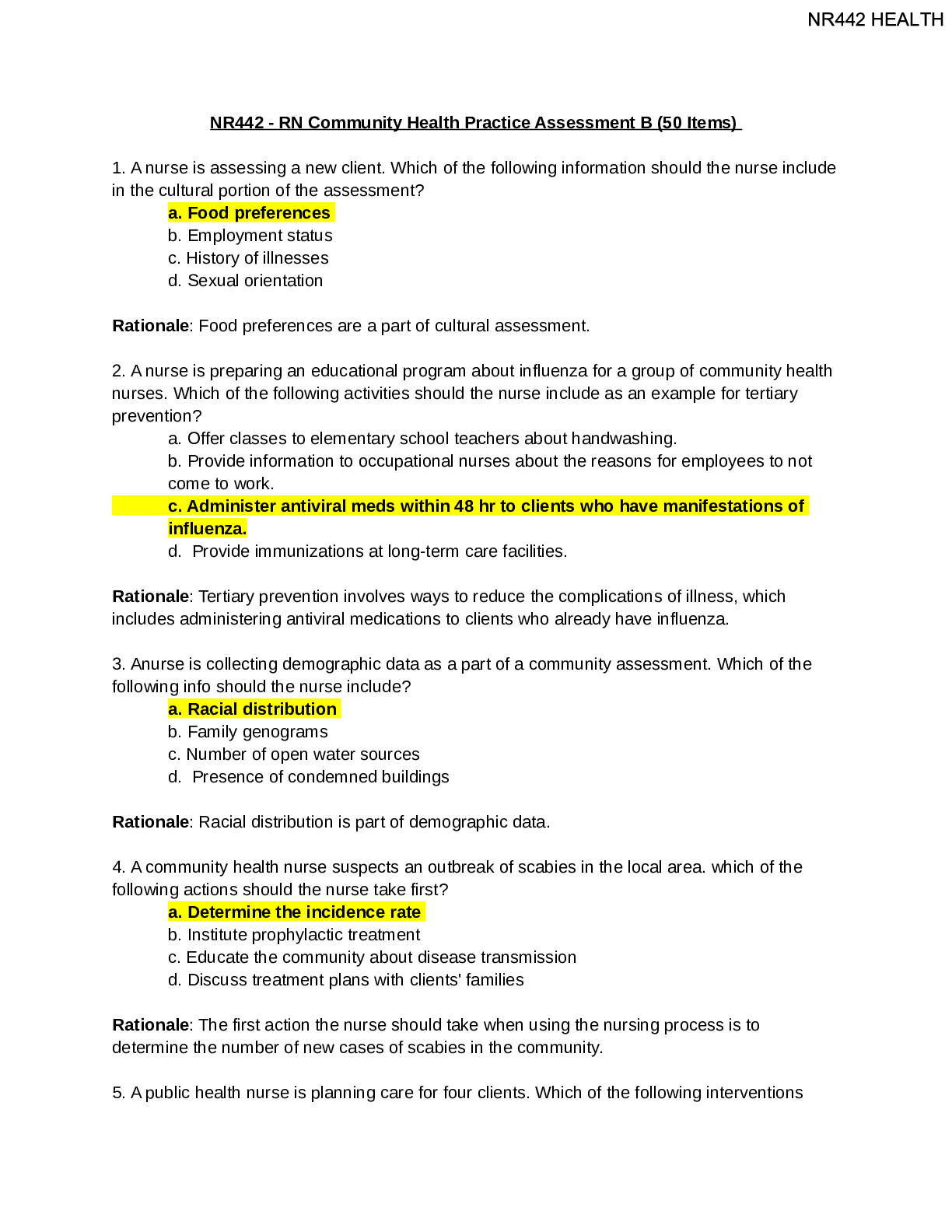
Reviews( 0 )
Document information
Connected school, study & course
About the document
Uploaded On
May 03, 2021
Number of pages
17
Written in
Additional information
This document has been written for:
Uploaded
May 03, 2021
Downloads
0
Views
21

.png)
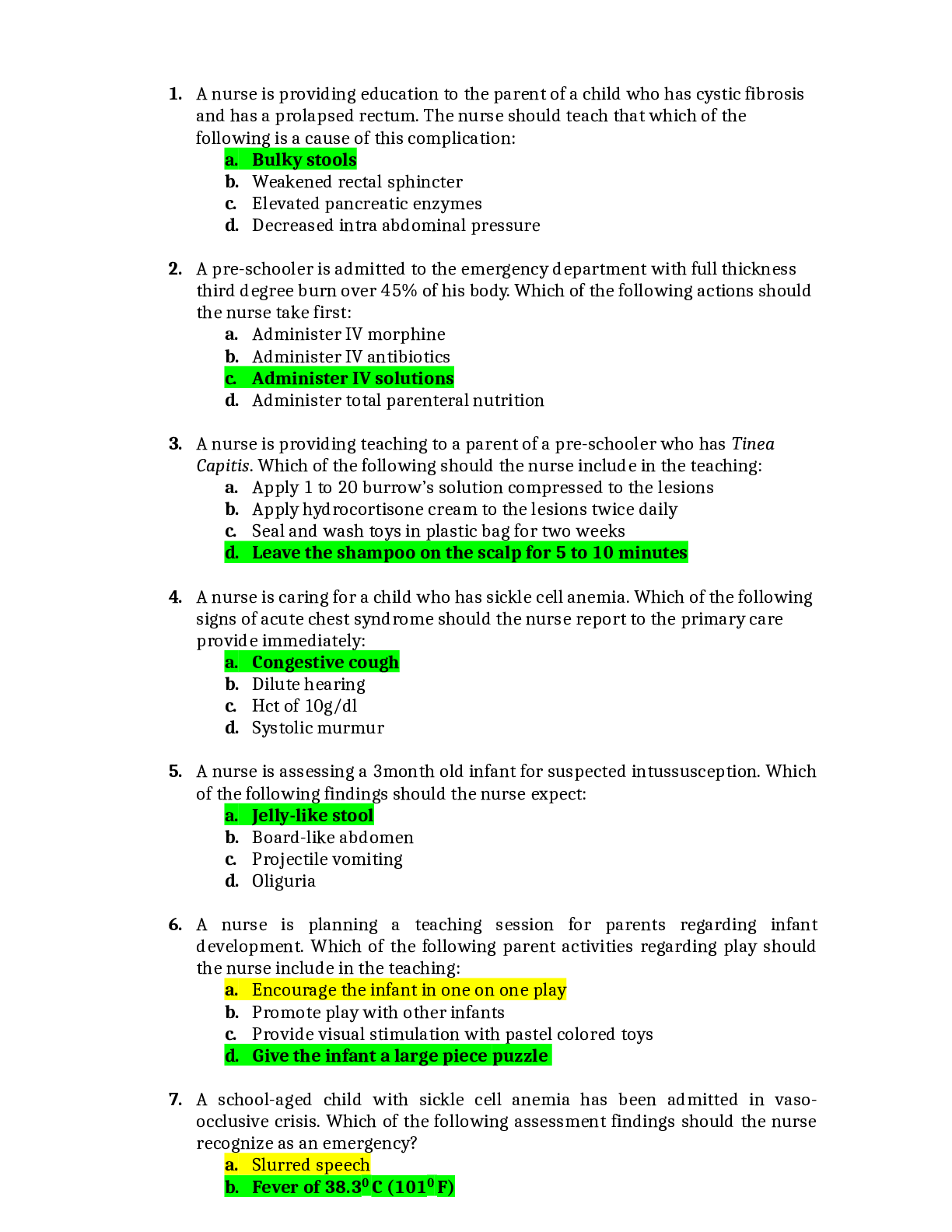


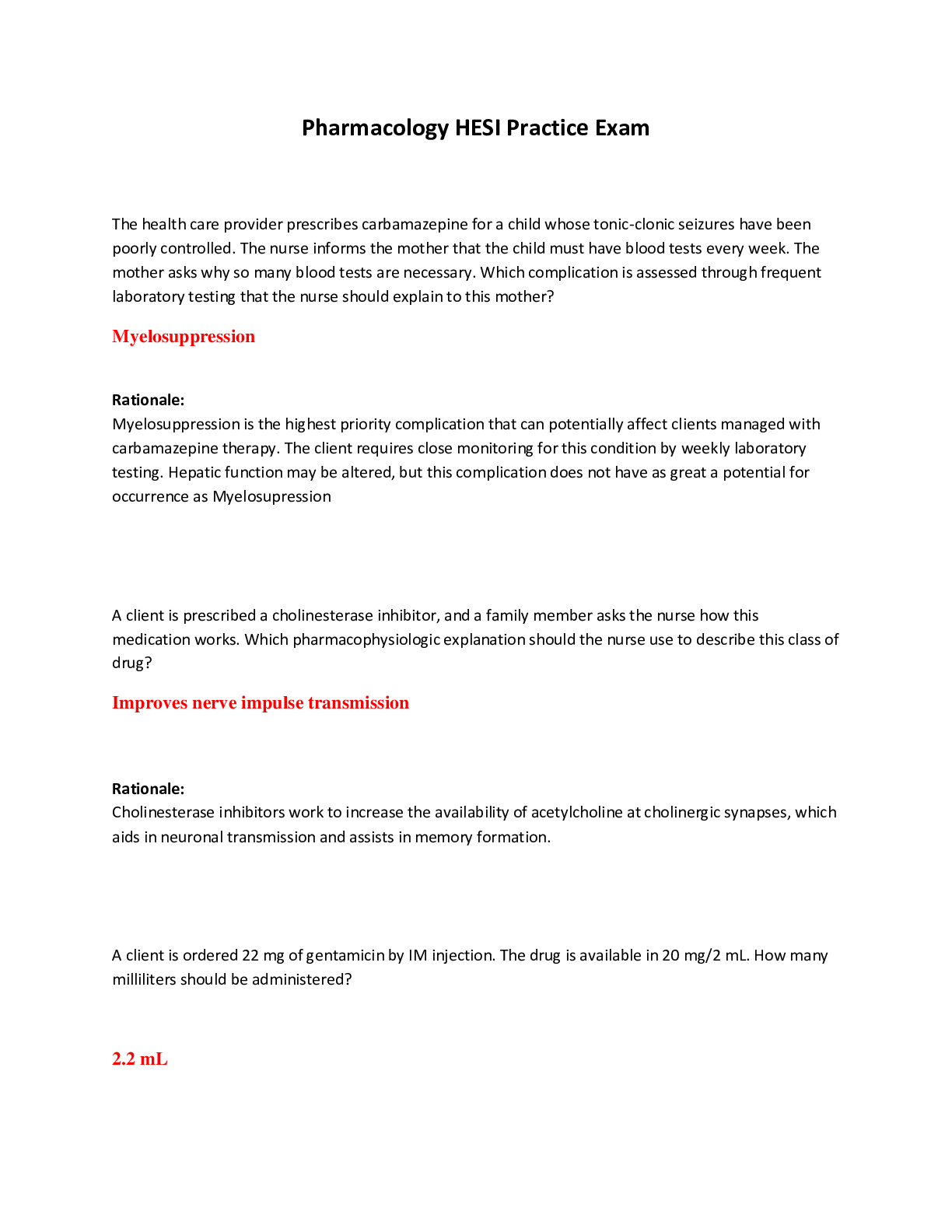


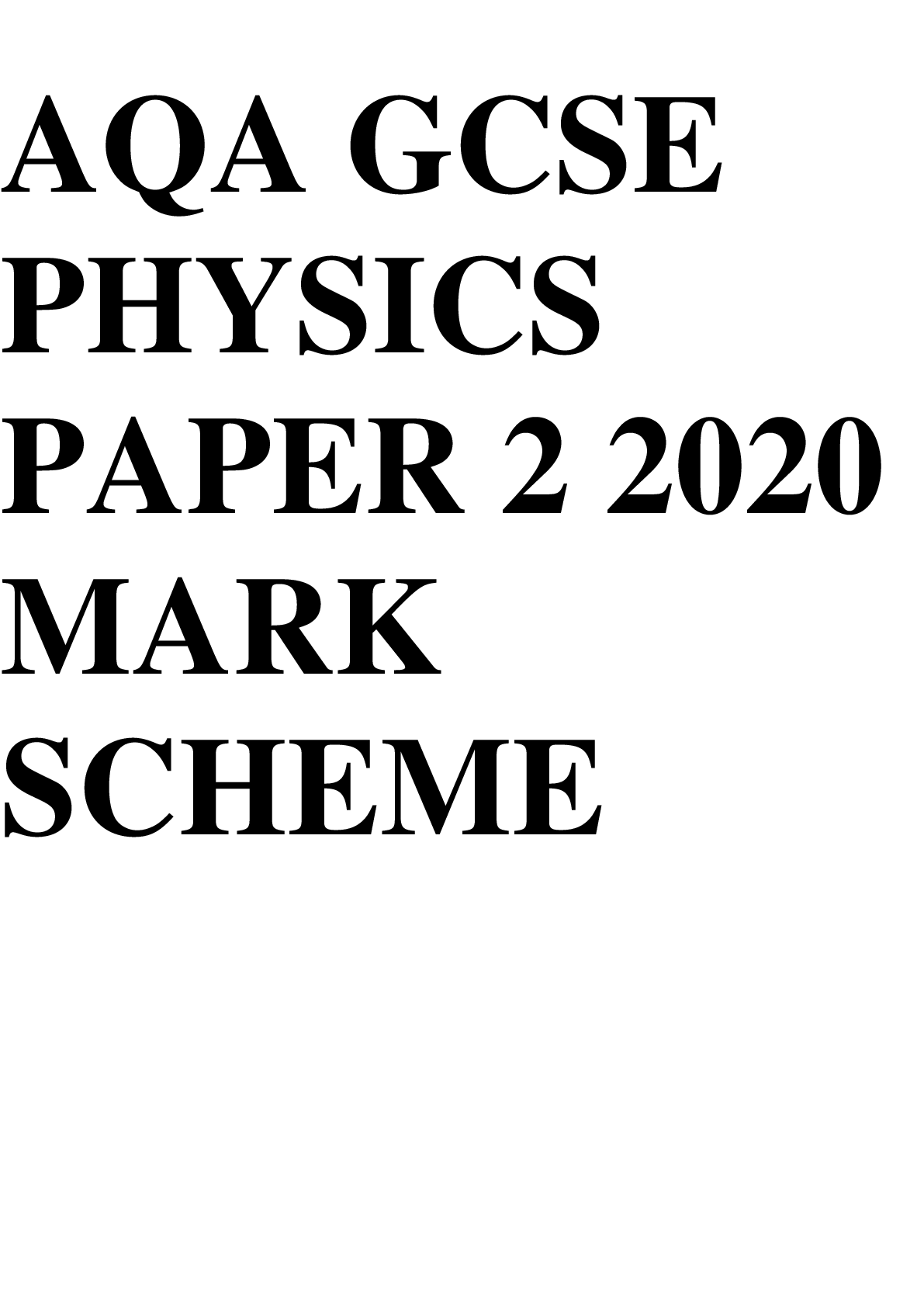

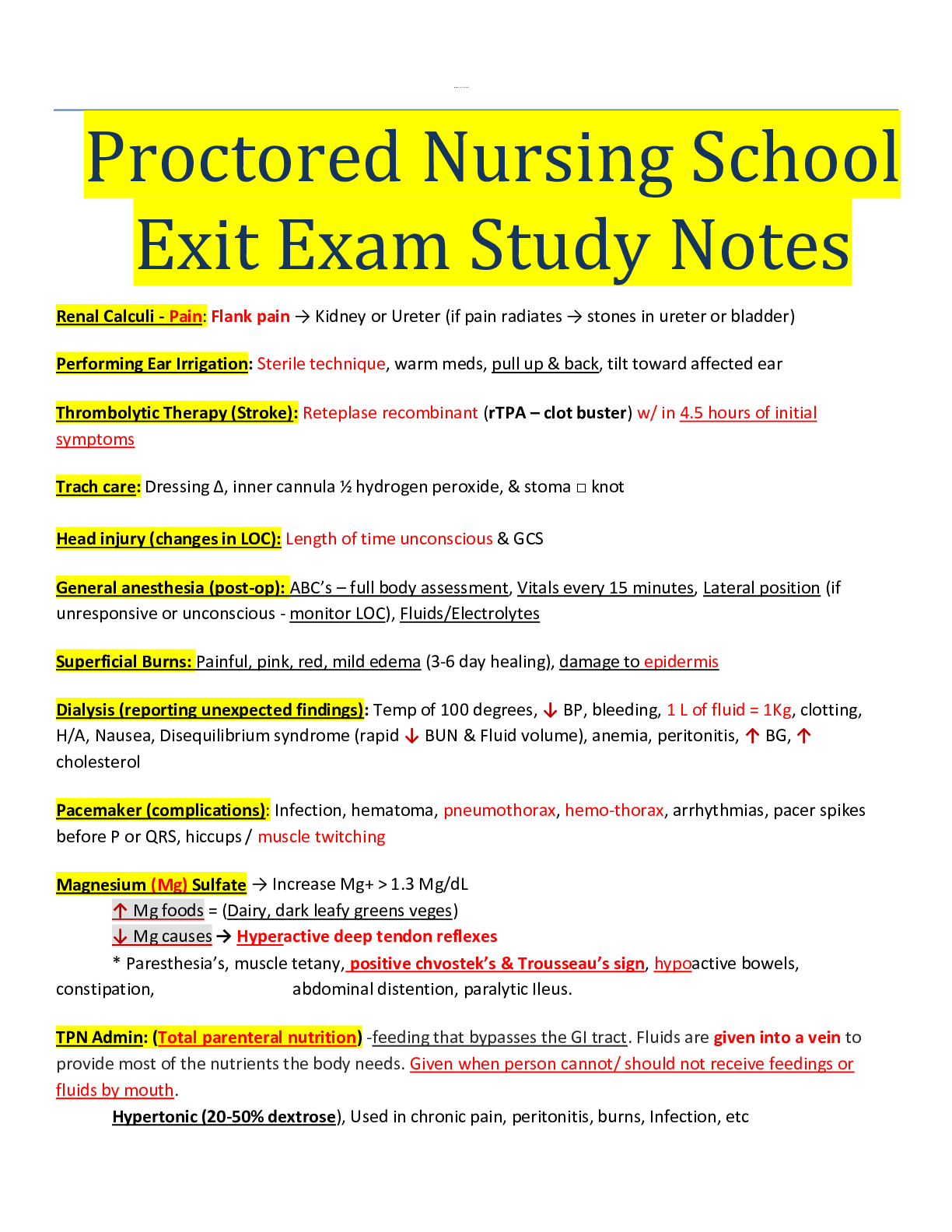
.png)
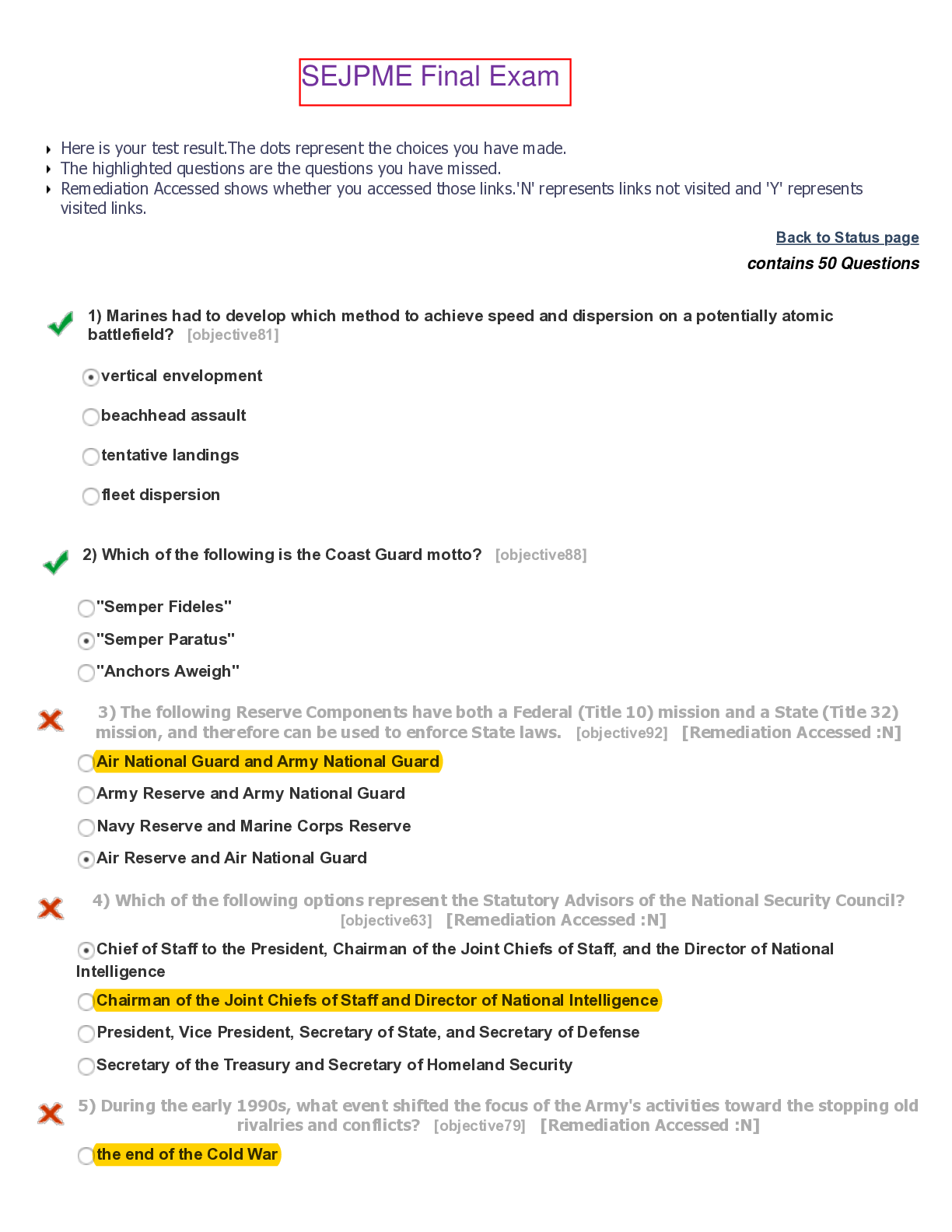
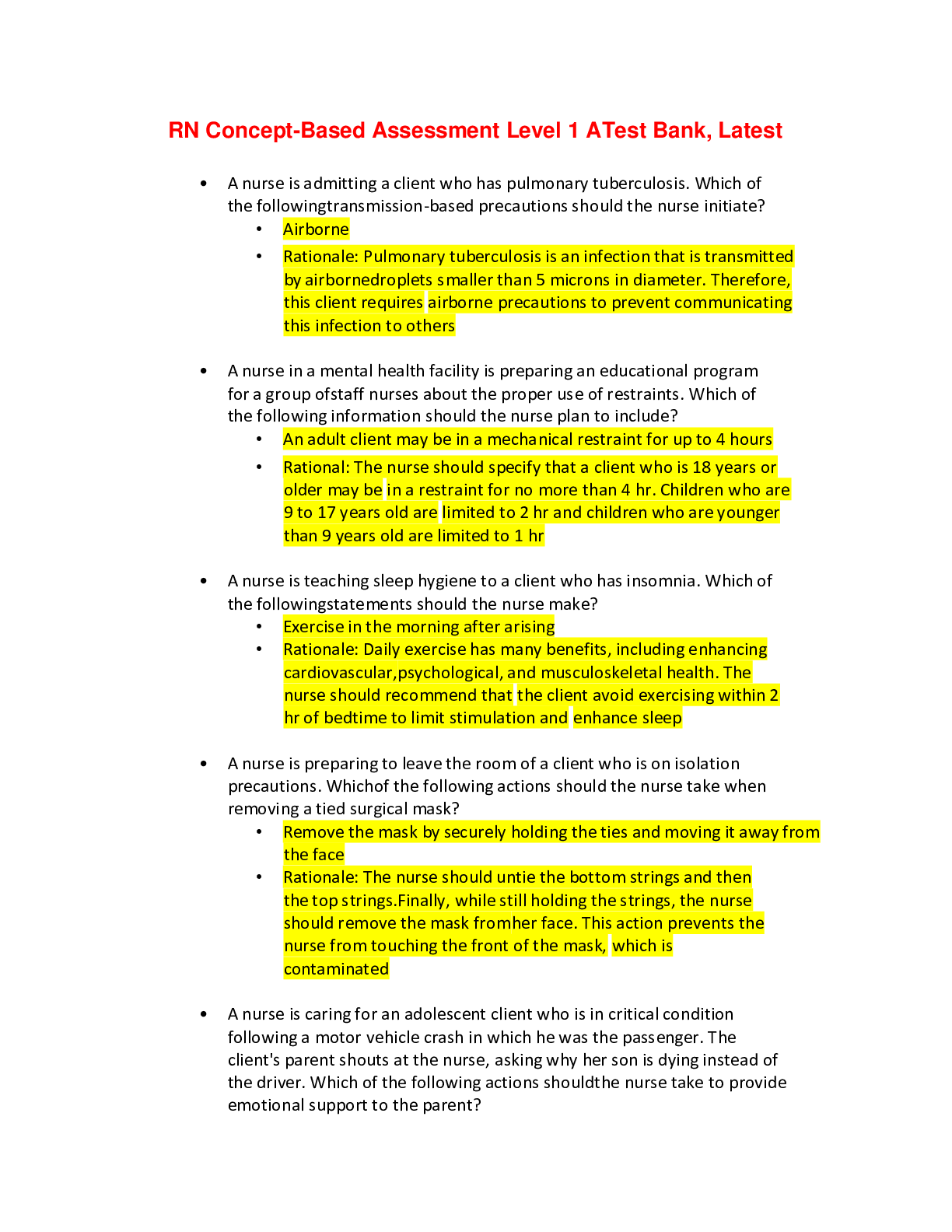
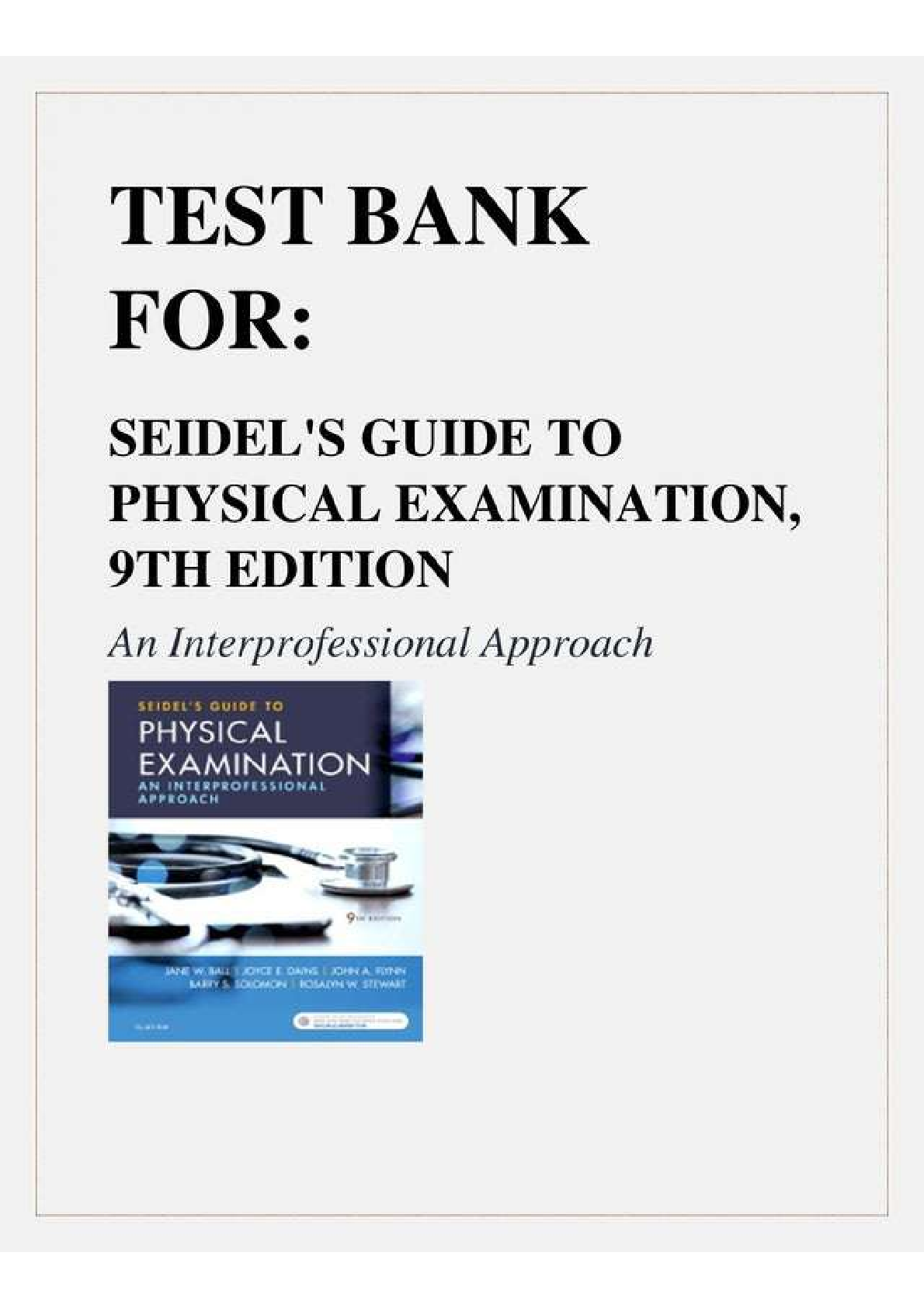


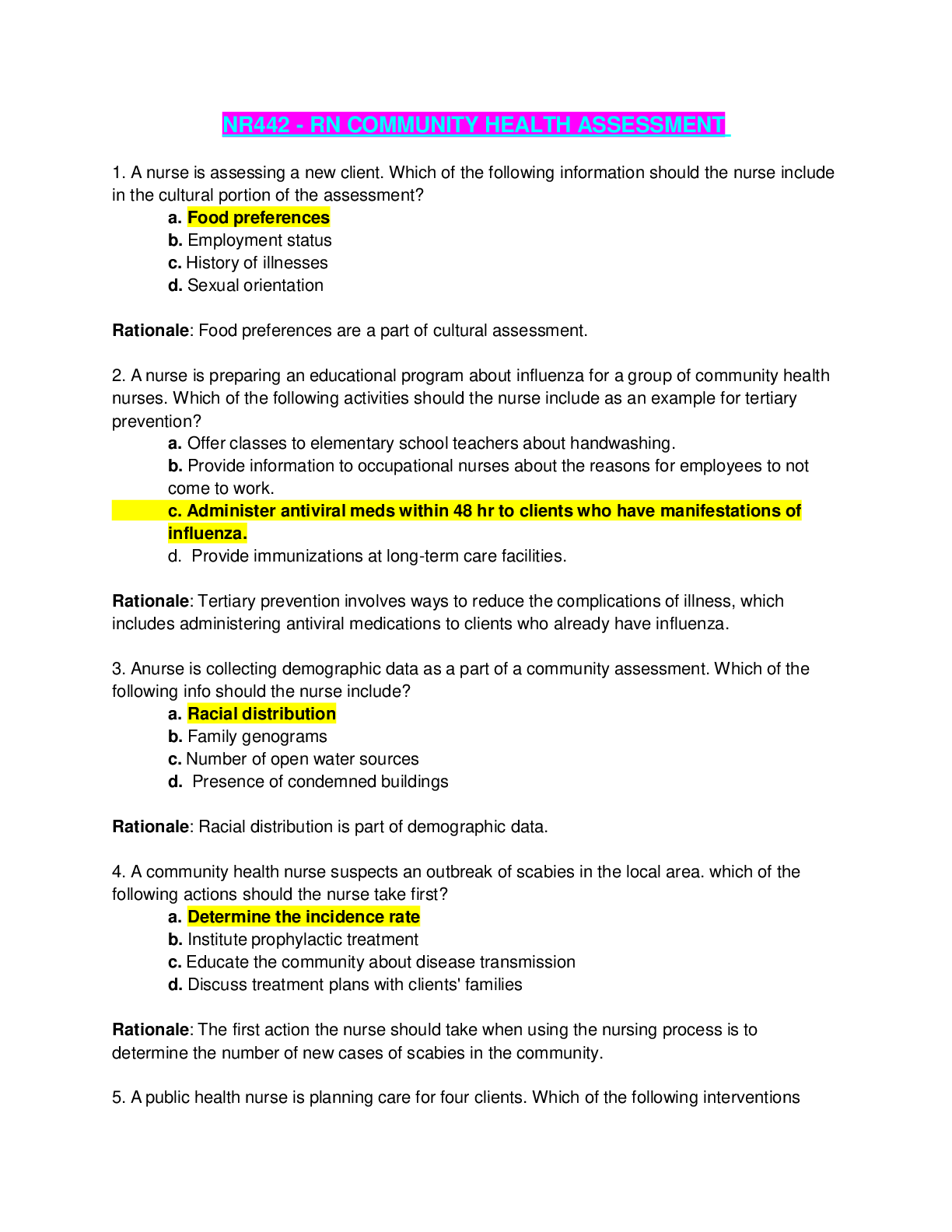

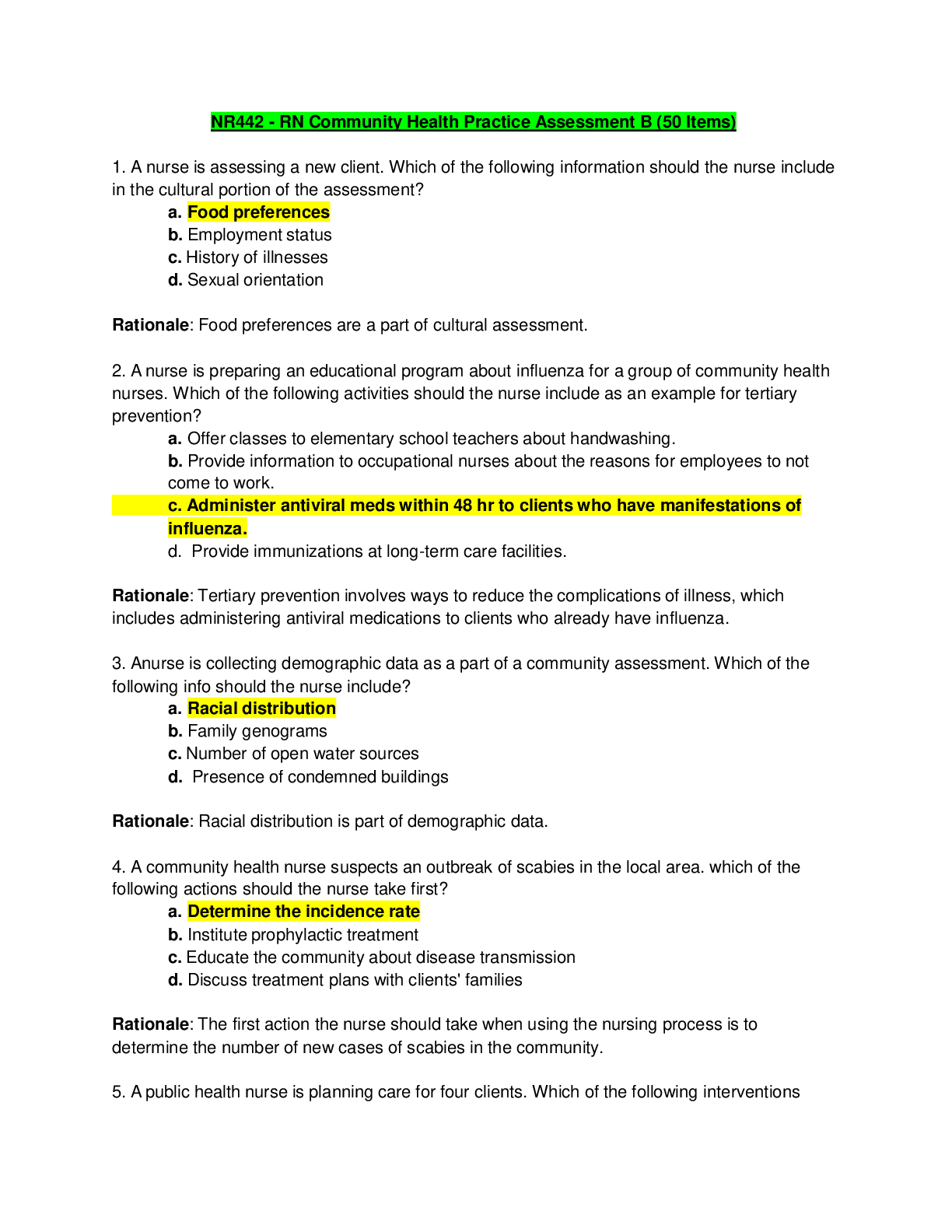
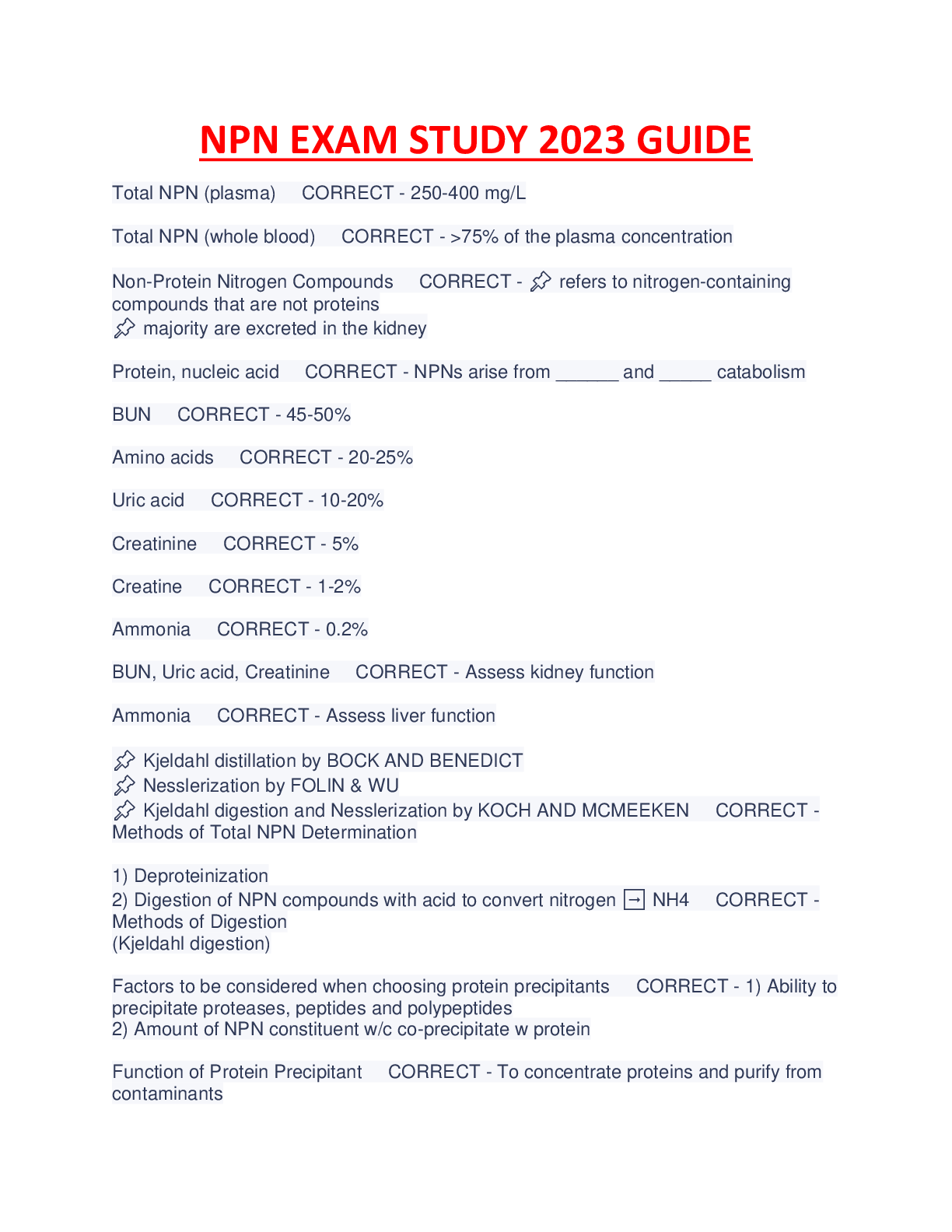
.png)
.png)




